Sunday 20th August 2023

It depends what your definition of DRT is, but there’s no doubting the go2 scheme in Sevenoaks operated by Go-Coach Hire Ltd is successfully fulfilling its objective of supplementing the rather limited urban bus routes serving this well-heeled town in north west Kent.

go2 is a successful shared taxi service. Austin Blackburn the energetic, entrepreneurial owner of Go-Coach acknowledges go2 fits between being a taxi and a bus with a number of characteristics that make it stand out from other schemes I’ve been reviewing in these blogs over the last five years which I’ll explain shortly.

But first to remind readers I featured Austin’s plans for go2 when I reported on a visit to his Go-Coach Hire operation in Sevenoaks back in October 2019. At that time Austin was planning a fleet of six-seater taxis on a clever combination of ferrying commuters in the early and late peaks to and from the station, SEN (Special Education Needs) journeys for the Edication Authority at school times, contracts for Age UK at lunch times and on demand taxi-buses at other off peak times.
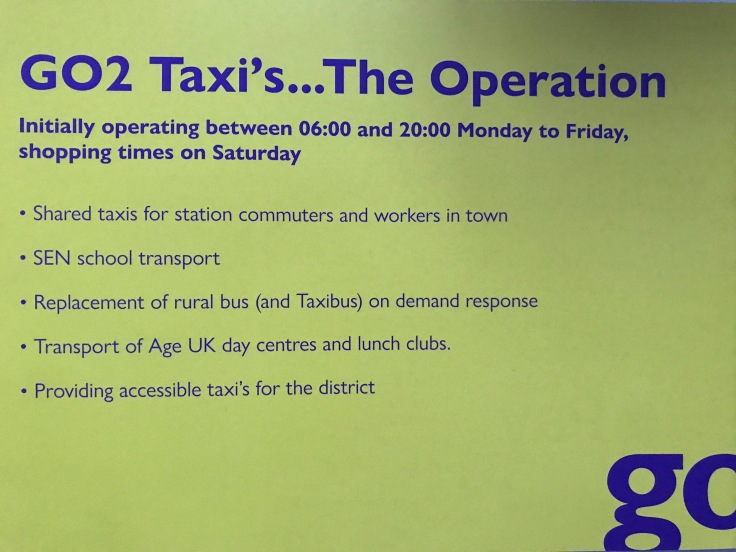
I described it then as “an ingenious plan” combining different revenue streams including guaranteed contracted income over the peaks, and explained discussions with local authorities were in advanced stages with a view to phasing the scheme in from May 2020.
Obviously Covid blew a hole through that plan but nothing ever fazes Austin and he used lockdown as an opportunity to test the local market for DRT by converting all the company’s bus routes based on Sevenoaks over to demand responsive operation (using phone bookings and an app developed with Via in record time) using standard single deck buses to allow for social distancing.

Although numbers travelling were obviously very low due to the stay at home/avoid public transport messaging from Government, that experience gave Austin a valuable insight into what might be possible as the pandemic eased which I reported on in June 2020.
Fast forward to a year ago, in August 2022, and the six-seater taxis finally got going for booking by phone or via the app throughout the Greater Sevenoaks area complimented by the gradual return of limited off-peak conventional buses on a few timetabled services.

Over the last twelve months the arrangements have gradually been tweaked based on experience including reducing the area covered by go2 and, from the end of last month, increasing the number of timetabled journeys on routes 1 (Westerham) and 6 (Kemsing) so both are now hourly during the off-peak morning and early afternoon as is town circular route 8.

Route 2 to Swanley continues with just two off-peak return journeys and route 5 has three return journeys to Tonbridge via Weald Village

Along with hourly route 429 between West Kingsdown and Dartford it takes just six buses to operate that network but it’s worth noting Go-Coach Hire’s overall PVR is 26 with 25 being committed to school work at school times.
go2 taxis fill the gaps not covered by routes 1, 6 and 8 and part of routes 2 and 5. The town also sees Arriva’s 402 (Tonbridge and Tunbridge Wells)…

… and RedRoute Buses 308 (Borough Green and Gravesend).
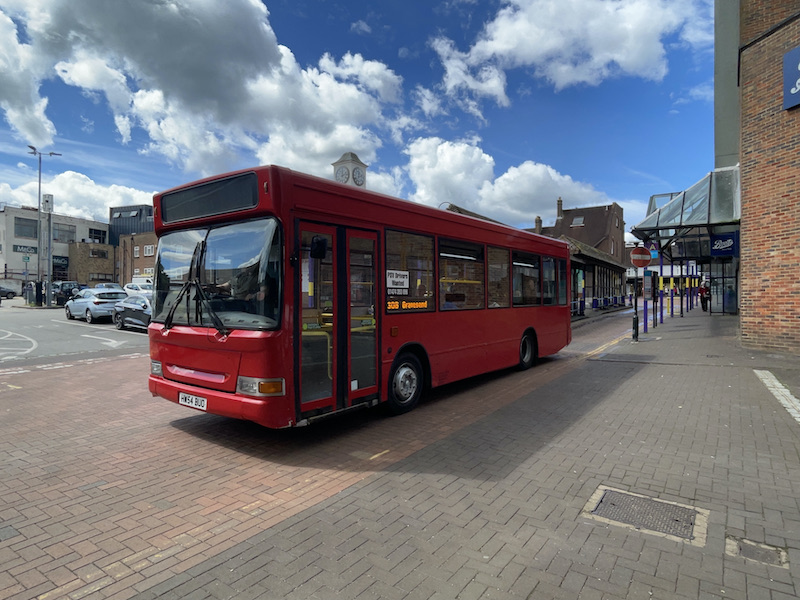
Three go2 taxi vehicles are used with a gradual build up from one on the road at 06:00 to all three by 07:30 concluding at 19:00 on Mondays to Saturdays; a trial of Sunday operation proved unsuccessful.

I took a couple of rides using go2 on Monday 7th from Sevenoaks to Brasted (on the A25 towards Westerham) and from the new development at Ryewood at Dunton Green to Sevenoaks.

For the first journey (which I initially thought I’d ride to just east of Sundridge rather than Brasted) the app offered me the choice of a go2 journey in either 20 or 31 minutes or the scheduled hourly route 1 departure in 27 minutes.

I passed up on those options and tried booking again eight minutes before the bus on route 1 was scheduled to depart and interestingly the app just offered me that as an option.

Next up I tried to book again just after the route 1 bus had departed and it again offered me the choice of two go2 rides – in nine and 32 minutes – or the next scheduled ride on route 1 in 57 minutes.
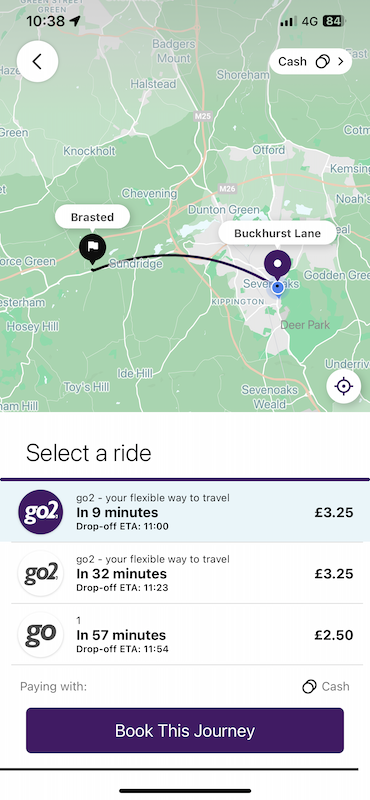
These examples demonstrate how go2 does indeed supplement the scheduled timetable for route 1, albeit the fares charged are different which I’ll discuss shortly.

The taxi/minibus which arrived was a larger Fiat Ducato and took just me for the ride over to Brasted.

The interior gives a more spacious feel than the six seaters (see later) and the driver, who was a taxi driver was very much enjoying working the go2 network.
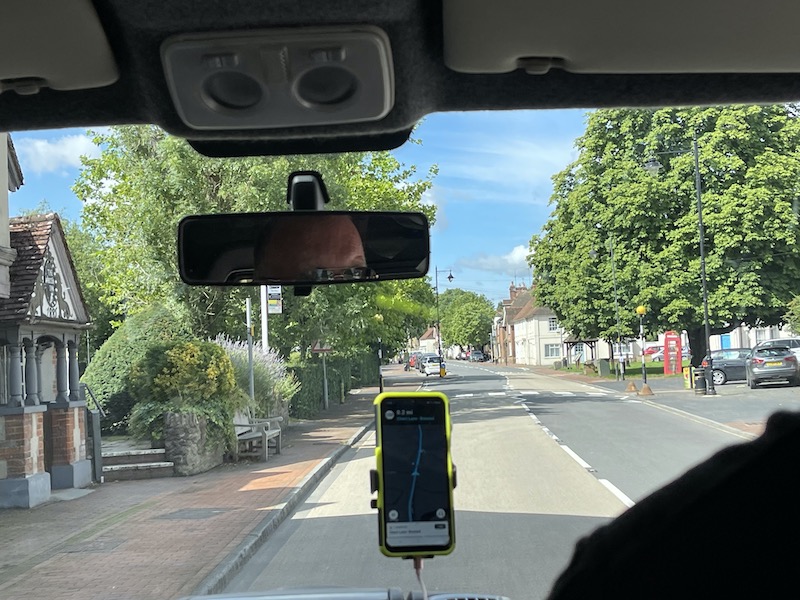
It didn’t take us long to reach Brasted and rather conveniently we arrived …
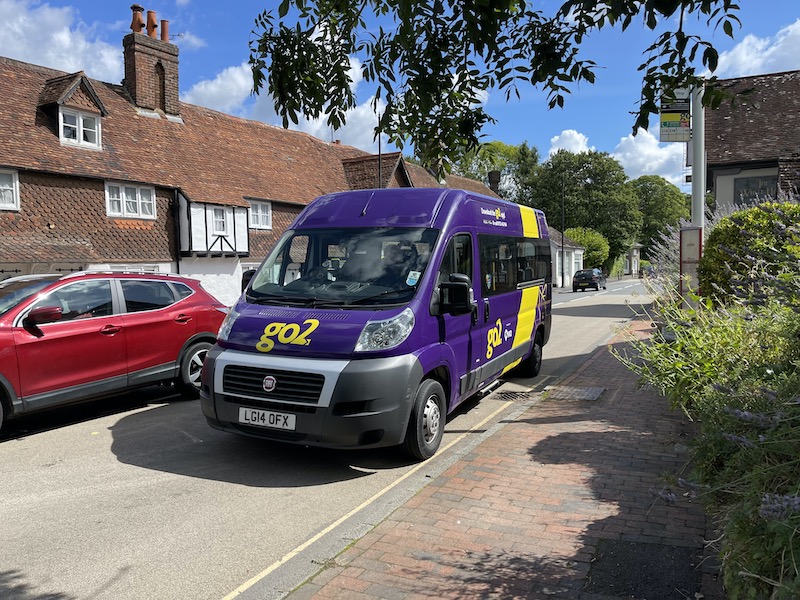
… just as the scheduled bus on route 1 was heading back from Westerham to Sevenoaks so I crossed over the road and caught that to the large Tesco at Dunton Green on the northern outskirts of Sevenoaks.

From there I walked to the relatively new housing development at Ryewood by Dunton Green rail station and used the app to book a ride in 16 minutes …

… to take me back into Sevenoaks.

This time it was one of the Ford six-seaters and what’s more we picked another passenger up with her young son on the way back into Sevenoaks dropping them off at Sevenoaks rail station.

As you can see, it’s rather ‘cosy’ in the six-seaters -one seat is alongside the driver…

… and I can imagine all the more so if all five seats are occupied and there’s luggage and shopping too.

The wheelchair space at the back is also rather restricted space wise but there looked to be a rather elaborate ramp for access.

After those ride experiences I travelled over to Go Coach Hire’s base in Swanley to have a chat with Austin who gave me a fascinating insight into why go2 is working where others are blatantly failing.

Here are ten reasons including some of my own observations.
1. The first is Austin himself. He’s a trained engineer by profession and is very astute when it comes to commercial decision making. Austin is hugely passionate about his business and he knows the Sevenoaks area bus market like the back of his hand. He’s been personally involved in go2 from the original concept through the Covid redesign and more recent developments over the last couple of years, fine tuning it along the way.
2. It’s significant that go2 supplements the Go Coach bus network with both being operated by the same company.
3. Using taxi type vehicles means Austin recruits taxi drivers to operate go2 rather than PCV drivers thereby reducing employment and wage costs.
4. The back office/personnel for go2 including call handling is the same office/personnel handling bus enquiries and are based locally.
5. Concessionary passes don’t give free travel on go2 but instead attract a half fare concession after 09:30 thereby bringing in revenue.
6. The geographic area covered by go2 is compact – around a five miles radius from central Sevenoaks.
7. Prices charged are more akin to taxi fares than bus fares and are higher in the morning and afternoon peaks reflecting the true cost of that operation. For example a five mile journey before 09:30 and after 15:00 costs £8.80 in the peaks and £7.70 between 09:30 and 15:00 when concessionary pass holders pay £3.85. A plus-one travelling with a passenger pays a flat £1. A £3 flat fare applies on Go Coach Hire’s conventional bus routes and school buses have a £3.50 contactless single, £5 cash single, £7.50 return and £35 10-journey options for children. There are no other concessions for children.
8. Passengers can only book a go2 journey at the time they want to travel. No advanced bookings are possible.
9. Kent County Council are subsidising go2 with £350,000 per annum which Austin points out wouldn’t fund similar coverage using conventional buses on scheduled timetables across the area.
10. Austin is well aware of the limitations from go2 but in addition to constantly tweaking the operation (eg hours of operation of each vehicle and geographic reach) he’s got one eye on future development possibilities, for example taking on the back office work for the County Council’s Dial-A-Ride Kent Karrier operation.
Summarising the foregoing the lack of an advance booking facility coupled with a confined geographic area means passengers can’t tie up a vehicle for a potentially significant amount of time well in advance of their intended travel meaning when bookings are taken, and for shorter journey lengths, there’s more chance of marrying up with other passengers while the reduced costs of running taxis (and taxi drivers) compared to minibuses (and PCV drivers) and taxi style fares and a financially supportive County Council means the finances stack up too.
It would be nice to think those responsible for the ailing DRT schemes I’ve reviewed could take a look at go2 and see what Austin has achieved and learn some lessons.

Next Sunday’s blog will take a look at another model of DRT operation which gets underway today linking Dedworth with Heathrow Airport Terminal Five.
Roger French
Blogging timetable: 06:00 TThS and Su DRT extras


We use the excellent route 8 town service frequently whenever we visit our daughter in Sevenoaks and always hope it will continue. We also go to Westerham and to Tunbridge Wells on Arriva. Go-Coach always seems to be an excellent operator, with printed timetables too.
LikeLiked by 1 person
With fares like £8.80, is this really a bus at all? Which begs the question, why not just book a minicab?
LikeLiked by 1 person
I agree. The fares being quoted are significantly higher than Lincolnshire’s Call Connect in my area, which is well known to be seen as too expensive by potential users, and I’m really not sure this scheme should be being lauded the way it is.
All the other DRT schemes which are rightly lambasted are (poor) attempts to provide a bus service at bus fares with bus conditions of travel on minibuses.
This is clearly a shared taxi scheme, using taxi not buses and running under taxi licencing which, presumably because it’s provided by a bus company, Roger’s choosing to treat as DRT.
But it’s one of Roger’s chums and unfortunately Roger does sometimes seem to brush over the negative side of anything his chums are doing.
LikeLiked by 1 person
Because the Council is paying more half the taxi fare for you? A five mile taxi from Sevenoaks would be £4.20 for the first half mile and then £3.30 a mile. That would make the taxi equivalent of the £8.80 fare mentioned above £19.00. Interestingly there is a presentation quoting the per passenger subsidy as £12.32 – stick that ontop of the £8.80 and you get to £20.00 or basically the same as the taxi fare. This actually seems to be what numerous people on this blog have suggested is a better alternative to DRT – the Council just massively subsiding taxi rides around its area.
LikeLiked by 1 person
So, it’s a shared taxi scheme not DRT. We agree!
LikeLiked by 2 people
If you can find a 5 mile taxi anywhere in the South for a consistent £8.80, I salute you. It’s only 80p cheaper up here than £8.80 in the North West with the likes of Uber. I grew up in Berks and took an 11 mile metered taxi the other day to a country pub. It was just under 35 quid!
LikeLike
I can see I’m out of date on taxi fares – I never take them myself – but these are not really really like bus fares either. As was explained by another comment, once the subsidy per rider is factored in, these are taxi fares. It’s a subsidised taxi service.
LikeLiked by 1 person
If a subsidised taxi service makes public transport viable in the area, then it is a worthy use of subsidy,no?
LikeLike
1. Note that there is now no travel from Sevenoaks to/from the Orpington area at all… Go-2 originally replaced the 431/3, but this area is now mostly Go-2-less, AND the 3 never returned. Not Austin’s problem, but both TFL and KCC have washed their hands of this area too.. with Sadiq’s ULEZ set to penalise some folk now forced to make this journey by car, of course the mayor doesn’t feel any obligation to provide any kind of alternative either, because non Londoners can’t show their displeasure at the mayoral elections!
And 2. With all the praise that is always heaped on Austin’s style in general, why was his Amazon AZ such an utter shambles of an operation in comparison? It could have given the down at heel Arriva a real run for its money had it been given the fighting chance their other operations appear to have been.. for me the impression of brand “go” was really tarnished by the way that ended up being operated…
LikeLiked by 1 person
I had assumed that it was Amazon pulling the plug rather than Go-Coach not performing, but I ciuld ge wrong.
LikeLiked by 1 person
” why was his Amazon AZ such an utter shambles of an operation”
I never got to travel on the AZ route, as I never got round to doing the Discovery Ticket womble around Kent and Sussex I had planned which would have included it. Was it unreliable on a day-to-day basis? Or were there other issues?
LikeLike
Although there was a nice poster for the service, it lacked details of which STOPS the route served, (eg “Gravesend stn” could be one of about 6 or 7 stops in 3 different roads, none of which had any number or publicity shown, especially the “correct” one!).
Google guessed that at the Dartford end, the stop was actually IN the car park turning circle – It wasn’t, yet the first actual stop again bore no timetable or route identification. Buses were cut on a regular basis, and drivers of those that did run actively avoided picking up anyone who looked like they wanted to board.. I witnessed this on numerous occasions, and suffered sailing-by vehicles myself even when I was standing in the road waving at the driver who had CLEARLY seen me. No wonder nobody used it, most weren’t actually able to!
LikeLiked by 1 person
Ouch.
Glad I never tried it; a bus sailing by me like that would have completely destroyed my planned day trip…
A. Nony Mouse
LikeLike
What really killed the bus is that frequent train between Sevenoaks and Orpington. All the significant settlements in between have stations too.
And Orpington’s southern suburbs have a decent bus service too.
Places that are going to be hit harder than ULEZ are places like Slough, Stevenage and Hemel, because there’s a higher percentage of of tradesmen with non-compliant diesel vans commuting into Greater London living there for the rent.
LikeLiked by 1 person
I assumed Austin was “fazed”, rather than “phased” (para 5) !
LikeLike
I grew up in Sevenoaks, and have lived there more recently also (though not at present). In the 1950s and 60s it had interurban LT green buses 401, 402, 403 and Maidstone & District 9, plus GreenLines 704 and 705, and coaches to London and Camber. Local/village buses 404, 413, 421, 431 and 454, plus M&D 55, 68, 105 and 106, and Thames Weald to Gatwick and Romford. Most routes ran until late-ish, but took no account of e.g cinemas, which were popular then. Buses were good for work, schools and shopping, but getting to see friends was not necessarily easy, as most routes ran hourly, and there was little co-ordination, except the excellent area bus+train times booklet by LT, the bus station enquiry office, and that buses on the main corridors were timed to give an adequate combined service. M&D couldn’t serve Sevenoaks station, and LT chose to route only the 402, 403, 431 and the GreenLines past it.
As in many towns, gradually rising incomes put a car in the sights of families, including my own; that gave at least a perception of lower travel costs (for the family) and a much wider choice of places to get to easily. The bus companies reacted as usual with fare increases and driver-only operation, making the services slower and less reliable, so more people bought cars. No thought of trying to win a share of the new-found demand for travel, or improving services in other ways. In particular, no attempt to join with the railways in creating a better public transport network. In fact the railways went off on their own, building car-parks and, over the years, putting on more trains, such that we now have six fast trains per hour to London and Tonbridge. Whereas on the buses there are … well, half-hourly 402s to Tonbridge (but not from the rail station), and Go2, which, when I was last in Sevenoaks, didn’t seem to be advertised at the station – I hope it is now.
I do think there is a demand for public transport, even in well-heeled places. Sevenoaks people use tubes, overground and buses when they are in London, so they know how to do it. A new generation takes climate change very seriously (as do some of us oldies), and will use public transport when it’s there for them.
LikeLiked by 1 person
In response to point 1, don’t Southeastern provide a service between Sevenoaks and Orpington, generally four times an hour, from early morning until late evening, seven days a week?
LikeLike
(Apols, that was a response to comment from Mackay)
LikeLike
If the go2 is so great why did they pull it out of Swanley and surrounding villages. People who live in Eynsford ( like myself ) used to use it alot on the weekends. Now we got to wait for the number 2 bus that runs just twice a day or walk to White Post Corner in Farningham, which as a person of passing years is sometimes not able to do. Then also stop the late night service with run for a few weeks before Christmas 2021. Also why stop the Sunday go2 when they took over the 401 bus route from Ham travel earlier this year ?
LikeLike
Malc M obviously has a strong pair of legs, as yes indeed, Orpington is but nine minutes away on a train, but unless you are pretty fit, the half mile climb up to the Town is beyond many. With such a limited bus service now linking Station and Town, Sevenoaks is out of reach.
The ridiculous situation that adjoining towns such as Bromley/Orpington-Sevenoaks and all that lies in-between (including the very popular Polhill garden centre) have no bus link whatsoever bring shame upon both TfL and the KCC. I thought the TfL had a remit to cater for both those wishing to travel into and out of it’s boundaries, and is in complete contrast to the situation in Surrey where the “this bus has been instructed to wait at this stop to even out the service” nonsense can be heard in far off Dorking.
Go2 DRT is clearly having some reasonable success in the local area, and I am sure the £1000 per DAY subsidy helps somewhat, but without normal bus links to Bromley, Edenbridge, Maidstone and Swanley, potential passengers in the area face a bleak future. How long before Arriva decide to walk away from the Town’s only half decent bus link to Tonbridge?
LikeLike
[image: WP_20210412_11_17_36_Pro (3).jpg] [image: WP_20210506_12_54_18_Pro (2).jpg] [image: WP_20210417_13_50_03_Pro.jpg]
LikeLike
Looks like you can’t post images in comments here, as none of those show.
LikeLike
This is the most surprising post I have read in a long time.
In case I’ve misunderstood the gist of the article, the future for DRT is:
1) Pay drivers on the cheap;
2) Use cramped, inaccessible buses (the fact they have a wheelchair lift is irrelevant – how often will a rear wheelchair ramp be used in reality or be practical?);
3) Charge the same fare as a taxi;
4) Exclude concessionary fare holders from free travel;
5) Still require a subsidy of over £300k p.a. (presumably after other revenue streams like SEN transport is included?).
Shall we just call it a Taxi with an app.?!!
All the above with the traditional DRT features like having to book ahead or no vehicle being available when you need to travel!
I’m also intrigued to know how a service like this is licensed given it would appear separate fares are charged and the operating area is limited. Other DRT schemes are registered as flexible bus services and as such allow the £2 fare cap and concessionary fares to be reimbursed. I am also assuming the taxi fares are higher because they are not zero-rated for VAT. Any ideas out there?
LikeLike
The vehicles are licensed as Private Hire, and operate under a Special Restricted O Licence. From the gov.uk website:
“Special restricted licences are used to operate a licensed taxi on a local service. You can only apply for this licence if you’re a licensed taxi operator. A local service is one where:
stops are no more than 24.15 kilometres (15 miles) apart
at least one stop is within the area of the district council that issued your taxi or private hire vehicle (PHV) licence
The service must be registered with the local Traffic Commissioner.”
LikeLike
Not sure why this is getting such a great write-up – I found a conference presentation by AB which quotes the local authority subsidy as £12.32 per passenger (which seems in the ballpark since the same presentation quotes 39,000 passengers PA and the blog mentions £350,000 subsidy just from Sevenoaks DC). It would certainly be interesting to hear the views of the (rest) of the local taxi trade about the Council basically spending a third of a million quid a year subsidising what appears to be a direct competitor to them.
LikeLike
My mistake – the £350,000 is from Kent CC. Sevenoaks put in an additional £70k from the CIL pot to buy two of the four “taxis”.
LikeLike
You all go on about go2 taxis. When it started out during the pandemic, they were using small buses driven by bus drivers. It was not until the middle of 2022 there were 3 of the minibus taxis being driving around Sevenoaks. One was driven by a counciler.
They still used small buses at times when they could .
Also since Christmas 2022 they once again cut back the services, they cut the times the go2 ran and cut the times when you could use your concessions pass to get cheaper fares.
I used to use the go2 regularly to get and from work in sevenoaks from otford but now I given up on using them
LikeLike
I think in Rural areas taxi buses have a place fir providing short local bus services. In theses areas LA’s contract large numbers of taxis for school transport. these could be used to provide off peal local buses. It probably needs some changes in regulations so that VAT is not chargeable and that they can get BSOG assuming they cannot at present
The vehicles need to be People carriers or small minibuses and have a proper destination blind
My view is they should operate to a fixed route. The reasons for this is that what most people want. They want to know when a bus will turn up and when it gets to their destination
A second reasons is you do not have to pay for an expensive app and a third reason is you do not need to pay for people to take phone bookings
They should be able to accept Concessionary passes but still charge a small fare perhaps 25% of the full fare (Concessionary fare reimbursement though would only be applicable if the route was not making a profit
At a rough estimate in rural areas you are looking at needing to take about £30 an hour. DRT typically has higher costs and only seems to average about 2 passengers an hour
Running them as normal fixed routes I think 5 or 6 passengers an hour is achievable
LikeLike
Public transport that you can’t plan in advance to rely on to get you to an appointment, train, etc? I’m not sure why this gets such a glowing review? I’d have to drive, if I have no way of knowing if I’ll be able to travel when I need to.
LikeLike